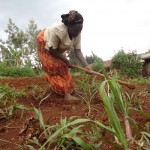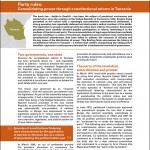Land is a “key fault line”1 in Kenya. Throughout East Africa, land reform has failed to confront the material consequences of unequal access. Since the 1990s, law reform has been the favoured means of addressing contentious land issues. Bilateral and multilateral donors have promoted the rule of law, administrative justice, formalisation of tenure, promotion of individual title, encouragement of property markets and technical solutions – the cornerstone of what has been termed “global land policy”. This template has led to land law reform, at the expense of substantive land reform.
New laws have not been redistributive or transformative in a positive way. Longstanding grievances and injustices have not been addressed. Legislation has failed to curtail predatory bureaucracies which in turn have stymied reform through delaying tactics and sabotage. After adopting a progressive National Land Policy and new constitution, Kenya missed a real opportunity to enshrine in law their radical principles for land reform.
By Ambreena Manji
Land issues have been the cause of much violent conflict throughout Kenya’s colonial and post-colonial history. In 2009, a National Land Policy was approved by parliament. The following year, land policy was embedded in a new constitution widely regarded as being radical – and potentially transformative. The culmination of a decade of often fierce debate and civil society activism, these events were described as “two significant achievements [that] have inserted the interests of ordinary Kenyans into this constitutional moment in a way that elections and constitutional ratification alone would not have”.2
The 2010 Constitution of Kenya addressed longstanding grievances over land, including the centralised, corrupt and inefficient system of administration identified in a series of reports of inquiry during the 2000s. Article 40 (1) sets out the principles governing land policy. These include equitable access; security of land rights; sustainable and productive management of land resources; transparent and cost effective administration; and elimination of gender discrimination in law, customs, and practice related to land and property. The process of translating these principles into law was widely seen as an opportunity to redress Kenya’s grossly skewed structure of land management and end predatory land practices by the state. It was one of the first, and certainly one of the most important, tests of the new constitution.
Despite the backdrop of optimism and anticipation, the drafting of the land law bills was characterised by undue haste, opacity and a lack of genuine consultation and debate. Indeed the final stage of the reform process can easily be interpreted as a last ditch attempt by certain parties to stymie it, subvert the intentions of the National Land Policy and renege on the promises of the constitution. The draft land bills were flawed, weak and seemed to be almost entirely disconnected from their guiding documents.
Parliamentarians failed to grasp the enormity, gravity and urgency of the task of land reform
In the run-up to the first and second reading of the bills in the National Assembly in February 2012, legal scholar Kithure Kindiki and others drew attention to incoherent drafting in the new laws; widespread borrowing of the provisions of other African countries without due attention to their relevance or suitability for Kenya; the failure to identify misconduct that the laws needed to address; inconsistencies between the National Land Policy and the constitution; and the failure to specify in detail the functions of devolved land administration bodies. The land research group in which I participated, Kituo cha Sheria, co-ordinated by the Katiba (Constitution) Institute, criticised the inscrutability of the drafts and the absence of any useful explanation of what policies were being implemented, or how. “This,” Yash Pal Ghai warned in a foreword to Kituo cha Sheria’s submission to the Parliamentary Committee on Land and Natural Resources, “effectively prevents the participation of the people in law making required by the constitution”.3
Parliament neglected to scrutinise or amend the land bills adequately and disregarded its obligation to heed the contents of the land and environment chapter of the constitution. Like many others, parliamentarians failed to grasp the enormity, gravity and urgency of the task of land reform. In April 2012, the assent of the Land Act, the Land Registration Act and the National Land Commission Act marked continuity with the past and the basic tenets of neoliberal land policy, for example by promoting land markets, providing for the individualisation of land tenure, and enshrining in law a presumption against customary tenure. A “technicist” approach and what is perceived as international best practice was prioritised over addressing political realities and local context.
The central concern of the laws is bureaucratic power and its control. While they did offer citizens some means to challenge bad administrative practices and so perhaps retain access to land, they did not embody the prescriptions of the constitution and National Land Policy. They were neither equitable nor transformative of land relations, nor was the “deep” redistribution envisaged by the constitution and National Land Policy upheld. This failure cannot be dismissed lightly. One expert commentator observed that “upon the outcomes of these deliberations may well hinge the future stability as well as the democratic quality of the Kenyan state”.4
Article 40 (1) of the Constitution of Kenya sets out the principles governing land policy and provides that “Land in Kenya shall be held, used and managed in a manner that is equitable, efficient, productive and sustainable”.Article 61 (1) states that “All land in Kenya belongs to the people of Kenya collectively as a nation, as communities and as individuals”.Article 40 protects private property rights; 40 (6) states that “The rights under this article do not extend to any property that is found to have been unlawfully acquired”.Article 68 (a) provides that Parliament shall revise, consolidate, and rationalise existing land laws. Article 68 (c) specifies areas for future legislation, including legislation to prescribe minimum and maximum private land holding; to regulate the manner in which land may be converted from one category to another; to “protect, conserve and provide access to all public land”; to protect the dependents of deceased persons with interest in any land, including spouses in occupation; and to provide “for any other matter necessary” to effect the land and environment requirements of the Constitution.
Abridged from Manji, Ambreena, “The Politics of Land Reform in Kenya 2012”, African Studies Review, Volume 57, Issue 1, April 2014, p.118
Kenya’s recent experience exemplifies critical shortcomings of land reform processes throughout East Africa. Since the 1990s international financial institutions, donors and governments have embraced law reform as a means to address a range of land issues, with varying degrees of sincerity and commitment. In essence, land reform has been land law reform.
This approach was prompted by a rediscovery of the role that law might play in development. The emphasis on law is not new. In the 1960s, the “law and development” movement held that law reform could promote economic development in newly independent countries. Interest subsequently waned due to scepticism as to the merits of this argument. The recent revival of law in development policymaking, and in particular the focus on the centrality of the rule of law to development, has had a major impact on how land issues have been addressed. Law has played a key role in what has been labelled “new wave land reform in an era of neo-liberalism”:5 land reform in East Africa has taken place in an “intellectual climate which rediscovered the importance of law as a major contributory factor in the international community’s support and pressure for land law reform within countries in the region”.6
In essence, land reform has been land law reform
The renewed prominence of law as a proposed solution to land problems has supported the representation of land as a tradeable asset that can be used to leverage loans. Secure formal property rights and developed land markets are considered a desirable goal of international and national land policy advocated by the World Bank and other multilateral and bilateral donors. Such legal constructs are portrayed as prerequisites for economic growth, poverty reduction and establishing the rule of law in developing countries. The formalisation and monetisation of land tenure have gone hand-in-hand as part of a “market-friendly” approach to land described by pre-eminent scholar, advocate and practitioner Patrick McAuslan in an important paper published in 2001 as “the globalisation of land markets”.7 The formalisation of land title and access to credit are now intricately connected in development policy prescriptions.
David Kennedy, currently faculty director of the Institute for Global Law at Harvard Law School, has argued that there is an unarticulated hope among law and development practitioners and academics that working within a strictly legal framework can substitute for, and thus avoid confrontation with, “perplexing political and economic choices”. This has placed “law, legal institution building, the techniques of legal policy-making and implementation – the ‘rule of law’ broadly conceived – front and centre”. It has excluded, rather than encouraged, contestation over economic and political choices; and the hope that law might substitute for contestation “encourages people to settle on the legal choices embedded in one legal regime as if they were the only alternative”. The rule of law, according to Kennedy, “promises…a domain of expertise, a program for action, which obscures the need for distributional choices or for clarity about how distributing things one way rather than another will, in fact, lead to development”.8
This observation helps us to understand why and how, over the past two decades, East African nations have felt compelled to reconsider land tenure regimes, adopt new land policies, enact new land laws and introduce programmes to ensure their implementation.
The consequences of a legalistic approach to land reform are starkly evident in Kenya’s new land laws. First and foremost, it foreclosed debates about redistribution, prioritising land law reform as the most effective way to address land problems and so evading more difficult questions about who controls access to land and how a more just distribution might be achieved.
A further consequence of the weight accorded to law as a means to resolve land issues is that amongst lawyers, civil society groups and scholars, it expedited a retreat into a technicist approach that ignored the wider political context and therefore missed an important opportunity for bringing about positive change. A constant rebuff deployed during public meetings of the Parliamentary Committee on Land and Natural Resources (the “Land Committee”) in Kenya was that the new land laws were highly technical and complex. Land law is complex, but this mantra, and severe time limitations, often seemed to be aimed at suppressing genuine debate and citizen participation.
Rather than challenging the retreat into technical legal responses, civil society groups largely accepted – and to some extent reinforced – this practice by assuming the role of mediator between the law and the people. This was mistaken. As Patrick McAuslan asserted, “to move from policy formulation to drafting laws is not, as some people assume, to move from a debate on policy to one on legal technicalities”. The technical is highly political. When ideas of equity and fairness come to be precisely defined, perceived winners and losers emerge. Objections and obstructions quickly arise. “These are not,” McAuslan continued, “objections on ‘policy grounds’ but on technical legal grounds; a particular clause ‘wouldn’t work’; a certain provision is ‘unnecessary’; another goes too far or is ‘impracticable’”.9
Acute distrust of bureaucratic power over land issues is widespread among Kenyans
Acute distrust of bureaucratic power over land issues is widespread among Kenyans. The allocation of public land in pursuit of patronage and profit has long been practised by successive presidents and their land commissioners. Civil society needed to wrest control of the debate from bureaucrats if the “intensely redistributive potential”10 of the National Land Policy and the constitution were to be realised. Instead, activists were distracted and mollified by the technical obfuscation that tends to be part and parcel of land law reform – and which typically reinforces the status quo.
The deficiencies of undue confidence in strengthening the rule of law and technical fixes are abundantly clear in Kenya when one examines the history of “bureaucratic sabotage”11 of land management and reform. The publication of the Report of the Commission of Inquiry into the Illegal/ Irregular Allocation of Land in Kenya (2004), widely known as the Ndung’u report after its chairperson, confirmed what Kenyans already knew: that land corruption was systematic and widespread. The commission found that at least 200,000 illegal titles to public land had been created between 1962 and 2002, 96% of them in the period 1986-2002, during the presidency of Daniel arap Moi. The categories of public land affected include forests, national parks and game reserves, wetlands, research farms, roads, government offices, settlement schemes, state corporation land and trust land. The Ndung’u report also showed how the constitutional requirement for public land to be administered “in the public interest” was consistently perverted by Presidents Jomo Kenyatta and Moi, public officials, members of the judiciary, well-connected politicians and businesses.To take urban land as an illustration, the commission found evidence of widespread abuse of presidential discretion with regard to unalienated urban land, that is to say public land legally available for allocation to schools, playgrounds and hospitals for the public good. Both presidents allocated land appropriated from landowners despite having no legal power to do so. Furthermore, the Ndung’u report also confirmed that a number of land commissioners had made direct grants of government land without any authority from the president. Often, land had been quickly sold by grantees at very high prices to third parties without any adherence to the conditions laid down by letters of allotment, which only have the status of letters of offer and cannot be sold. Far from being restrained by the principle of public purpose, successive land commissioners and many local authorities completely disregarded it and sold land reserved exclusively for public purposes. Forged letters and documents were commonly used. Records at the Ministry of Lands and Settlements were found to have been deliberately destroyed.The “juicy findings”12 – the “what” – of the Ndung’u report attracted a great deal of attention. With a few notable exceptions, less was written about its exhaustive detail on the “how”: exactly how the law was routinely subverted and so much public land illegally or irregularly allocated for personal gain or political reward. Far from upholding the rule of law, the legal profession played a central role in land corruption for personal benefit, as did other professions. This is one of the most significant issues raised by the Ndung’u report, if not the most significant.
The legal profession played a central role in land corruption for personal benefit, as did other professions
The conduct of many Kenyan lawyers stands in stark contrast to the role of the legal profession envisaged and supported by donors – that of promoting good governance and the rule of law. Internationally-sponsored rule of law programmes are supposed to promote and embed a strict distinction between the professions and politics. The information about systemic professional misconduct and illegality revealed by the Ndung’u report should have rung far louder alarm bells internationally. It provided valuable lessons about the hazards implicit in translating the aspirations and promises of the National Land Policy and the constitution into law. Instead, the complicity of lawyers in the illegal and irregular allocation of land has been largely overlooked. Professional bodies have chosen to ignore the conduct of members in facilitating land corruption. To date, despite the findings and recommendations of the Ndung’u report, no investigations of professionals’ involvement or disciplinary action have been initiated.
When the legal framework governing the administration of Kenya’s land was reviewed, a key test that should have been applied was whether proposed changes in the law would have prevented the illegal and irregular allocations on the vast scale identified by the Ndung’u Commission. But the drafting, enactment and aftermath of Kenya’s new laws has facilitated “business as usual” for professionals who, screened by international and state endorsement of the technicist approach to land law reform, have sustained corruption for decades.
It is important to consider the consequences for ordinary citizens of land corruption going unpunished. The misallocation of public land instigates a process whereby something that should be available for the public good is transformed into private property. Kenyans are routinely deprived of their right to access to land for homes, schools, clinics, parks and cemeteries. For example, in one prominent case a questionable change of use enabled 18 acres in a suburb of Nairobi that had been reserved to build two state schools to be sold to a diplomatic mission. The schools were never built on this or any other site. In another, land reserved for the development of a public medical clinic and day nursery was, again through a questionable change of use, given over to the building of a shopping centre in an exclusive suburb of Nairobi.
The very real losses suffered by citizens through illegal dealings in land dwarf those of household name corruption scandals like Goldenberg and Anglo Leasing. Furthermore, they are augmented by abusing control of state corporations, a practice highlighted by the Ndung’u Commission: its report provided critical details about what happens in the aftermath of illegal or irregular land allocations. Ndung’u showed how those allocated land would move quickly to sell it, in many cases, to state corporations at hugely inflated prices. Pressured into making illegal purchases of public property, these institutions become “captive buyers of land from politically connected allotees”.13 In some cases, state corporations had also been the victims and not just the conduits for realising the profits of land grabbing – a further injustice.
The economic and social costs of widespread land corruption… will be borne by Kenyans for many years to come
The primary state corporation targeted to purchase stolen land, often at inflated prices, was the National Social Security Fund (NSSF), the Kenyan workers’ pension scheme whose purpose is to provide social protection against old age, death and incapacitating physical or mental disability. Although the full cost of the plundering of the NSSF has not been quantified, between 1990 and 1995 it spent Ksh.30 billion (about US$400 million) on the purchase of illegally acquired property. The NSSF’s assets may well be overvalued as a result of holding grabbed land, raising questions about its ongoing financial viability. The economic and social costs of widespread land corruption facilitated by the connivance of professionals and government servants will be borne by Kenyans for many years to come.
Another deficiency exposed by the statutory reform of land law in Kenya, and elsewhere in East Africa, has been the failure to reflect that different areas of law are interconnected. When law is the favoured means to improve land governance, reform has tended to focus on land law at the expense of other legislation. Often, inheritance law, family law and mortgage law are neglected despite their critical role in determining access to land. The effects on women are especially detrimental. For example, it is often at the point of inheritance that women can claim access to land so addressing women’s land rights needs to involve reform of succession, family, and other related areas of law. This is a point I raised when Tanzania’s new land laws were being formulated in the late 1990s.14 If the interconnectedness of law is not acknowledged and addressed, when the state wishes to resist progressive measures in land law, such as provisions that allow women to co-own property with their spouses, it can use inheritance law or family law to stymie women’s claims.A further, critical shortcoming in the way land law reform has been carried out in Kenya and East Africa is the failure to incorporate the concept of justice and connect it to wider struggles for equality. In his book Land Law in Eastern Africa: Traditional or Transformative?, Patrick McAuslan sought to encourage academics to frame land problems in terms of fairness, equity, and justice. The reports of international and domestic policymakers rarely discuss justice in the context of land, preferring to depend on the technicist approach. McAuslan contrasted this with South African scholarship in which writing about the African National Congress’s land reform programme, the constitutional provisions on land, and the future of urban planning have applied a justice framework.Fortunately, Kenyan civil society groups have not emulated the widespread neglect of the theme of justice in land law reform by academics, policymakers and donors. The Kenya Land Alliance, Kenya Human Rights Commission and others have made concerted efforts to introduce ideas of justice and injustice to discussions about the politics of land and debates about the direction of land law reform. I would argue that their work has had a profound impact on the terms in which land is discussed in Kenya today. In the wake of the post-election violence in 2007-8, Kenya established a Truth, Justice and Reconciliation Commission (TJRC) with a mandate stretching back to 1963. Its report, released in May 2013, provides perhaps the best illustration of links between land issues and claims to justice being openly acknowledged. The words “historical land injustices” are used throughout, despite not appearing in the legislation creating the TJRC. This term is said to have “entered the Kenyan lexicon in the context of activism and agitation for constitutional reform and the establishment of transitional justice mechanisms aimed at addressing past human rights violations”.15
Policymakers rarely discuss justice in the context of land
The 2009 National Land Policy and Article 67(1)(e) of the 2010 Constitution of Kenya preceded the TJRC in asserting the connection between land and justice, and significantly influenced its approach. The former, in setting out a land policy framework in Chapter 3, calls for “equity” and, most importantly, for “transparency” in relation to land. The latter refers specifically to the need to address “historical land injustices”. So, while justice is still largely overlooked in the pronouncements of donors and policymakers on land issues, and in the work of most academics, the very many injustices connected with land are gaining increasing domestic attention. Civil society groups now consider unlawful evictions due to insecurity of tenure, misallocation of land by powerful governments, land grabbing by elites, the use of land as a patronage resource during elections and for ethnic mobilisation as questions of human rights, equity, and justice. This is a significant step forward.
The Ndung’u report has proved to be a resource of immense value, despite the failure to implement its recommendations and enshrine them in Kenya’s new land laws. The National Land Policy and the land and environment chapter of the 2010 Constitution of Kenya were milestones of great importance. The efforts of donors to strengthen the rule of law played a part in enabling Kenyans to realise these achievements. But the disproportionate focus of donors, policymakers and academics on law, the omission of the theme of justice, and an overly-technical approach that ignores political realities are deficiencies in the common “global” approach to land reform glaringly highlighted during the drafting of Kenya’s new land laws. Instead of the redistributive, transformative land reform enshrined in the National Land Policy and constitution, Kenyans received incoherent land laws that threaten further to undermine the rule of law and to perpetuate the country’s long-running land corruption, conflict, injustices and inequalities.
Kenyans received incoherent land laws that threaten further to undermine the rule of law
The most obvious response of the Ministry of Lands (MoL) to the reduction in its powers contained in the National Land Commission Act 2012 has been to underfund the new National Land Commission (NLC). The NLC was handicapped from the outset by the poor drafting of the act that established it as a supposedly independent body responsible for the administration of land in Kenya. Wrangles between the MoL and NLC over their respective mandates, staffing and funding have consumed more time and energy than addressing the very real land problems facing the country, not least ongoing land grabbing. This constitutes an important reminder of the difficulties of wresting control over land from those long accustomed to using it as a patronage resource.
Kenya’s land issues are not unique. But the attempt at land reform and the new land laws are a real test of the hard-won 2010 constitution. The inclusion of land tenure matters in the constitution raised the stakes. If the new laws fail to mitigate historical injustices and curtail predatory practices, it will create further disillusionment among ordinary Kenyans and risks being perceived as a failure of the constitution itself.
Publication of the Report of the Commission of Inquiry into the Land Law Systems of Kenya (the “Njonjo Commission Report”).
Report of the Commission of Inquiry into Illegal/ Irregular Allocation of Land 2004 (the “Ndung’u Commission Report”) presented to President Kibaki and released six months later, following widespread criticism of government’s failure to make it public.
Publication of the Commission of Inquiry into Post-Election Violence following the December 2007 General Election (the “Waki Commission Report”).
National Land Policy approved by parliament.
Referendum on new constitution.
Following approval by two-thirds of voters, new constitution promulgated.15 and 22 February 2012
Land Bill, Land Registration Bill and National Land Commission Bill receive first and second readings in the National Assembly. In the run-up to these readings academics, commentators and members of civil society attending consultative hearings struggle to find up-to-date versions of the bills.22 February 2012
Parliamentary Committee on Land and Natural Resources holds first consultative hearings with members of the public on the day the final draft bills are released by the government printer. Few attending, including committee members, had the opportunity to read the bills beforehand. Many groups state publicly that the bills fail to enact the land and environment chapter of the constitution, and call for complete withdrawal and revision of bills. Some point out that they would fail the test of constitutionality. Minister of Lands and Chair of the Committee on Land and natural Resources reject appeals on grounds that constitutional deadlines cannot be breached.9 March 2012
National Assembly approves by two-thirds majority an extra 60 days for wider consultation on the draft bills. Extension is supported by Constitution Oversight Committee, Legal Affairs Committee and Land Committee.19-23 March 2012
Members of the Land Committee undertake tour of Kenya’s 47 counties. Committee’s conduct of consultations widely criticised for “ineptitude” and “complacency”.
Late March – early April 2012
Land Committee convenes a retreat in Naivasha to discuss its findings, followed by one week “technical retreat” in Mombasa.
16 April 2012
Proposed amendments to land bills become available. Instead of the revision and redrafting widely called for, the amendments are brief. The most important changes on which commentators were unanimous, such as the need to detail the role and powers of the proposed national land Commission in relation to the Ministry of Lands, are left unaddressed.
26 April 2012
Largely unaltered land bills approved by Parliament.
27 April 2012
Land bills receive presidential assent and are enacted.
Abridged from Manji, Ambreena, “The Politics of Land Reform in Kenya 2012”, African Studies Review, Vol.57, Issue 1, April 2014, pp.115-30
NOTES
1 Hornsby, Charles, Kenya: A History Since Independence, IB Tauris, London, 2012, p.787
2 Harbeson, John W., “Land and the Quest for a Democratic State in Kenya: Bringing Citizens Back In”, African Studies Review 55 (1), 2012, p.15
3 Manji, Ambreena, “The Politics of Land Reform in Kenya 2012”, African Studies Review 57 (1), April 2014, pp.120-1
4 Harbeson, John W., “Land and the Quest for a Democratic State in Kenya: Bringing Citizens Back In”, African Studies Review 55 (1), 2012 p.15
5 Bernstein, Henry, “Land reform: taking a long(er) view”, Journal of Agrarian Change 2, 2002, p.433
6 McAuslan, Patrick, Land Law Reform in Eastern Africa: Traditional or Transformative?, Routledge, London, 2013, p.2
7 McAuslan, Patrick, “From Greenland’s Icy Mountains, From India’s Coral Strand: The Globalisation of Land Markets and its Impact on National Land Law”, paper given at a conference at Belo Horizonte, Brazil, 2001
8 Kennedy, David, “Laws and Developments” in Hatchard, John and Perry-Kessaris, Amanda (eds.), Law and Development: Facing Complexity in the 21st Century, Cavendish, London, 2003, pp. 9-17 passim
9 McAuslan, Patrick, Bringing the Law Back In: Essays in Land, Law and Development, Ashgate, London, 2003, p.251
10 Sessional Paper No. 3 of 2009 on National Land Policy, Republic of Kenya, p.75
11 McAuslan, Patrick, Bringing the Law Back In: Essays in Land, Law and Development, Ashgate, London, 2003, p.348
12 Southall, Roger, “The Ndung’u Report: Land and Graft in Kenya”. Review of African Political Economy 32 (103), 2005, p.142
13 Report of the Commission of Enquiry into Illegal/Irregular Allocation of Land, Republic of Kenya, 2004, p.92
14 See Manji, Ambreena, The Politics of Land Reform in Africa, Zed Books, London, 2006
15 The Final Report of the TJRC, The Truth, Justice and Reconciliation Commission of Kenya, 2013














